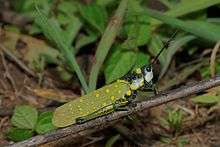Aularches miliaris
| Aularches miliaris | |
|---|---|
 | |
| Scientific classification | |
| Kingdom: | Animalia |
| Phylum: | Arthropoda |
| Class: | Insecta |
| Order: | Orthoptera |
| Family: | Pyrgomorphidae |
| Genus: | Aularches Stål, 1873 |
| Species: | A. miliaris |
| Binomial name | |
| Aularches miliaris (Linnaeus, 1758)[1] | |
| Synonyms | |
| |
Aularches miliaris is a colorful grasshopper belonging to the family Pyrgomorphidae found in South and Southeast Asia.[2] The bright warning colours keep away predators and their defence when disturbed includes the ejection of a toxic foam.[3]
The insect has been called by a variety of names including coffee locust, ghost grasshopper, northern spotted grasshopper, and foam grasshopper, and enjoys some popularity as a pet insect.
Description

The head and thorax are dark green with a canary-yellow band on the side. The tegmina are green with many yellow spots; the legs are blue, with a yellow serrated pattern on the hind femora. The abdomen is black with bright red bands.[3] Two subspecies have been designated, the nominate and pseudopunctatus.
Habits
It swarms in October, the mating and egg-laying season, collecting on bushes and grasses. It is heavy and sluggish, able to make only short leaps, very visible on vegetation.[3] Outbreaks leading to this species damaging cultivated crops are uncommon.[4]
When A. miliaris (of either sex) is disturbed or grabbed, it emits a sharp rasping noise from its thoracic segments. If its thorax is pinched, it also squirts a clear viscous mucus with unpleasant smell and a bitter taste, faintly alkaline, with many embedded bubbles. This foam comes out as a strong jet from apertures in the thorax, and more gently from other openings in the body (ten in total); it heaps up around the insect and partly covers it.[3]
Conservation
Autarchies miliaris, like most other grasshoppers, are considered a pest in agricultural areas; however it is also endangered or near threatened in South India.[5] A. miliaris lays eggs in the soil which aerates the soil promoting biodiversity and creates ecosystem value. Their interactions and natural process contribute to the health of the soil. The presence of a variety of insects in the soil are indicators of soil quality.[6] There are a few conservation efforts for this species. At times of high population, growth can be controlled by tilling the area where they deposit their egg pods or collecting the grasshoppers; pesticides are effective; however they are normally not environmentally friendly and can cause damage to other animals and vegetation.[7]
References
- ↑ Kirby, W.F. (1914). The fauna of British India, including Ceylon and Burma. Orthoptera. London: Taylor and Francis.
- ↑ (2013) Aularches miliaris miliaris (Linnaeus, 1758) from Orthoptera Species File (OSF) Online. Accessed on 2013-01-29.
- 1 2 3 4 Hingston, RWG (1927). "The liquid-squirting habit of oriental grasshoppers". Transactions of the Entomological Society of London. 75: 65–69. doi:10.1111/j.1365-2311.1927.tb00060.x.
- ↑ Jones, S (1940). "A Visitation of the Spotted Locust (Aularches miliaris L.) in Travancore.". Journal of the Bombay Natural History Society. 41 (3): 676–678.
- ↑ Josephrajkumar, A.; Rajan, P.; Mohanan, R; Jacob, P (2011). "Management and conservation dilemmas surrounding a Near-Threatened grasshopper, Aularches miliaris Linn. (Orthoptera: Pyrgomorphidae) in south India.". Journal of Orthoptera Research. 20 (1): 103–107. JSTOR 23034227.
- ↑ Lavellea, P; Decaënsb, T; Aubertb, S; Barota, M; Bureaub, F; Margerieb, P (2016). "Soil invertebrates and ecosystem services." (PDF). European Journal of Soil Biology: S3–S15.
- ↑ Josephrajkumar, A; Rajan, P; Mohanan, R; Jacob, P (1998). "Management and conservation dilemmas surrounding a Near-Threatened grasshopper, Aularches miliaris Linn. (Orthoptera: Pyrgomorphidae) in south India.". Journal of Orthoptera Research. 20 (1): 103–107. JSTOR /23034227.
External links
| Wikimedia Commons has media related to Aularches miliaris. |